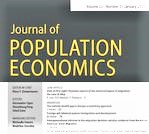A new paper published in the Journal of Population Economics finds that risk aversion has a robust and statistically significant negative impact on willingness to migrate within countries as well as abroad.
Read more in:
Risk aversion and the willingness to migrate in 30 transition countries
Peter Huber & Klaus Nowotny
Journal of Population Economics (2020) 33, Issue 4: 1463-1498
OPEN ACCESS
Author Abstract: This paper uses individual-level data covering 30 transition countries that account for over one-quarter of the worldwide immigrant stock to assess the impact of risk aversion on willingness to migrate. It extends the previous literature by allowing the effect of risk aversion to depend on the level of risk in the sending country. Consistent with theories of individual-level migration decisions, we find that risk aversion has a robust and statistically significant negative impact on willingness to migrate within countries as well as abroad. As predicted by theory, this impact is robustly less negative in riskier sending countries. Furthermore, this negative impact is significantly larger for willingness to migrate abroad than willingness to migrate internally. We also find that, even after controlling for an extensive set of control variables, willingness to migrate internally and abroad are highly correlated. This suggests that internal and international mobility decisions are closely linked.
Access to the newly published complete Volume 33, Issue 4, October 2020.
LEAD ARTICLE OF ISSUE 4:
Yun Qiu, Xi Chen & Wei Shi, Impacts of social and economic factors on the transmission of coronavirus disease 2019 (COVID-19) in China
Journal of Population Economics 33, 1127–1172 (2020). OPEN ACCESS

Ends;

